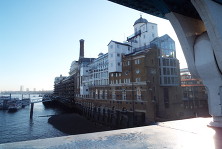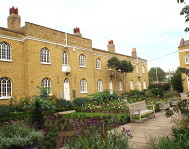








Hayles Buildings, Elliott's Row
Built at the beginning of the 20th century, Hayles Buildings are artizans' dwellings that line the east side of Elliott’s Row near the Elephant and Castle. They were built in two different phases in two very distinct styles. The foundation stone for the building to the north was laid in 1891 and the five storey high block is constructed mostly from yellow brick. It has an imposing front elevation with little decoration. The foundation stone to the block at the south end of Elliott’s Row was laid in 1902 and this block is generally
more attractive. Built with a mix of yellow and red brick, it is only four storeys high with a front elevation broken up with square bays, balconies and some arts and crafts style decoration.
The blocks were built by the Hayles Charity which today is part of the Walcot Foundation based in Lambeth. Its origins go back to the mid seventeenth century when St Mary’s Church in Lambeth had acquired a surplus of £300 and it was decided to use this surplus to help the poor of the parish. Six acres of land in St George’s Fields, just over the parish boundary within the parish of St George the Martyr, was purchased in 1671 from Robert Hayle, a haberdasher and citizen of London, and his wife Ann. At that time, the land was just an open field.
By 1850 the whole estate had been built upon by developers who had leased parcels of land within the estate on building leases. The charity’s income was spent on the Royal Infirmary for Children and Women at Waterloo, medical aid for poor persons, pensions to 28 deserving persons, and maintenance and support of infants, or ragged free evening schools. When the leases expired, the land, along with any houses that had been built, reverted to the charity. Usually these houses came to the charity in a dilapidated and unsanitary condition.* In the early 1880s, the houses on the east side of Elliott Row had reverted to the charity and whilst repair was investigated as an option, by 1883 it had been decided that as the houses were structurally incapable of repair and referred to in the Charity’s minutes as “dilapidated hovels”, they would be demolished and new houses constructed that would be aimed at letting to the “better classes of artizans”. But with an eye to improving income from the estate for the charity, it was later decided that a block of artizans’ dwellings would be built instead of houses. The architects Waring and Nicholson calculated that a block of apartments would be able to accommodate 720 people instead of only 375 persons in houses similar to those on the western side of Elliott’s Row built seven years earlier.
The entire Hayles Estate, which as well as Elliott’s Row also included Hayles Street and some buildings on St George’s Road, was put up for sale in 1978 in seven lots. The sales particulars state “The Trustees, although registered as a Charity, are not a Housing Charity and, under the terms of the Trust, the continued ownership of this estate cannot be justified, hence the sale.” The asking prices for the entire freehold was £750,000 and it was stated that many of the flats and houses required improvement to provide full modern amenities. The purchaser was Southwark Council and much of the estate is now in private hands. It falls within a conservation area.
*This was a frequent occurence for land-owners after the 19th century house building boom in London. See also Octavia Hill in Walworth.
Elliott's Row Pocket Park on the Corner of Elliott's Row and St George's Road began as a guerilla gardening project on neglected land in 2012 but soon acquired the backing of Southwark Council.
Web discoveries
- UK Casino Not On Gamstop
- UK Casino Not On Gamstop
- Non Gamstop Casino
- Casinos Not On Gamstop
- Non Gamstop Casinos
- Non Gamstop Casinos
- Non Gamstop Casino
- Casino Sites Not On Gamstop
- Slots Not On Gamstop
- Casinos Not On Gamstop
- UK Betting Sites Not On Gamstop
- UK Casino Not On Gamstop
- Best Non Gamstop Casinos
- Betting Sites
- Non Gamstop Casino Sites UK
- Best Non Gamstop Casinos
- Non Gamstop Casino
- Casinos Not On Gamstop
- Non Gamstop Casino Sites UK